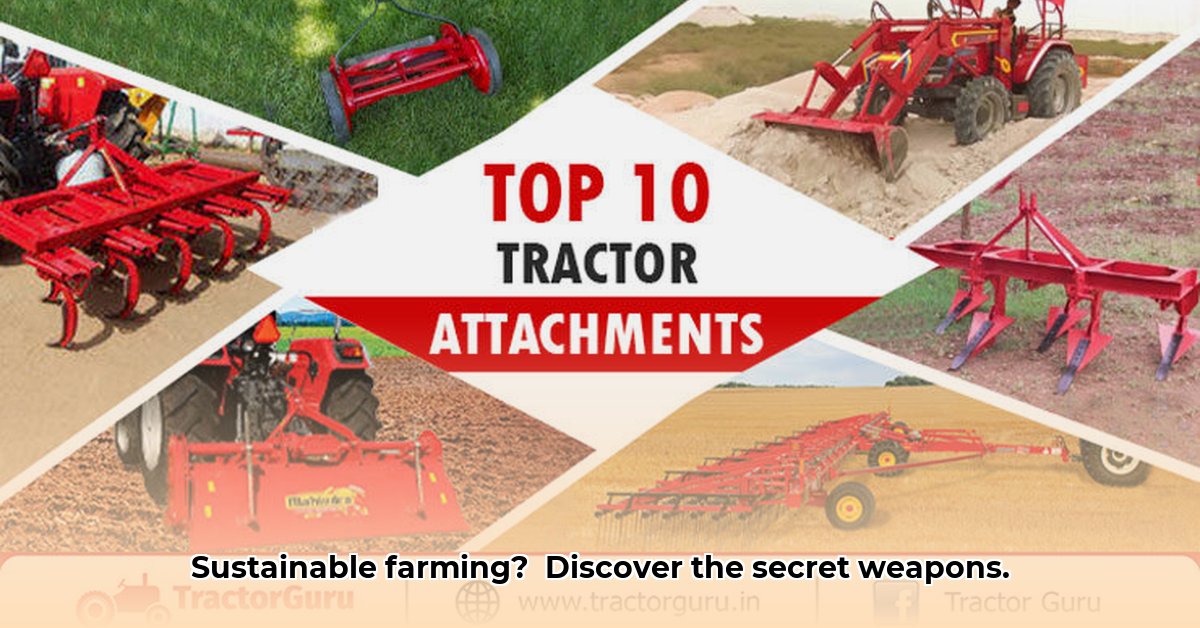
Sustainable agriculture is no longer a niche pursuit; it's a necessity for the future of food production. The tools we use play a crucial role in achieving this goal, and tractor implements are no exception. This article will explore various tractor attachments, categorizing them by function and analyzing their contribution to sustainable farming practices. We'll also delve into technological advancements and future trends to provide a comprehensive guide for farmers, researchers, and policymakers. How can we optimize our farming practices for both productivity and environmental responsibility? For more information on specific implements, check out this helpful resource: Tractor Implements.
Categorizing Tractor Implements for Sustainable Practices
Selecting the right tractor attachment is crucial for efficient and sustainable farming. Let's categorize them by their primary function:
Soil Tillage
Soil tillage prepares the land for planting. Traditional plowing, while effective in the short term, can disrupt soil structure, leading to increased erosion and reduced water infiltration. A more sustainable alternative is the no-till drill, which plants seeds directly into the existing soil, minimizing soil disturbance. Other options include cultivators and harrows, offering varying degrees of soil disruption. The optimal choice depends on soil type, crop, and specific farming goals. How can we balance soil preparation with soil health preservation?
Planting
Efficient planting is essential for maximizing yields and minimizing waste. Precision planting equipment, such as GPS-guided seeders, ensures accurate seed placement, depth, and spacing, leading to better germination rates and reduced seed usage. This precision minimizes the need for replanting and optimizes resource utilization. What benefits do GPS-guided seeders offer in terms of efficiency and sustainability?
Harvesting
Efficient harvesting minimizes crop losses and preserves quality. Combines equipped with optimized headers carefully collect crops, reducing waste and maximizing yield. Features like adjustable concaves and loss monitors further enhance efficiency and minimize environmental impact. How can we optimize harvesting techniques to reduce waste and maintain crop quality?
Material Handling
Efficient material handling is crucial for managing inputs and outputs. Tractor attachments such as loaders, pallet forks, and manure spreaders streamline the movement of fertilizers, harvested crops, and animal waste. This reduces fuel consumption, labor costs, and environmental impact. How can we improve material handling to minimize resource use and environmental impact?
Sustainability Aspects of Tractor Implements
The environmental impact of tractor implements is a critical consideration in sustainable agriculture. Several factors influence their sustainability:
Fuel Efficiency
Modern implements are designed with fuel efficiency in mind. Lower fuel consumption directly translates to lower greenhouse gas emissions. Choosing energy-efficient attachments is a significant step toward reducing a farm's carbon footprint. What are the key factors influencing the fuel efficiency of tractor implements?
Soil Compaction
Heavy machinery can compact soil, hindering root penetration and water infiltration. Using reduced-width attachments helps mitigate soil compaction, maintaining soil health and productivity. How do we minimize soil compaction while maintaining efficient farm operations?
Noise Pollution
Noise pollution from farm equipment can negatively impact wildlife and nearby communities. Quieter models are becoming increasingly available, reducing noise pollution and improving the overall environment. What are the technological advancements leading to quieter farm equipment?
Sustainable Materials
Some manufacturers are incorporating recycled or bio-based materials into their equipment, reducing environmental impact and promoting circular economy principles. What are the benefits and challenges associated with using bio-based materials in tractor implement construction?
Actionable Recommendations for Sustainable Farming
Farmers, manufacturers, policymakers, and researchers all have a role to play in promoting sustainable agricultural practices:
Assess Needs: Begin by identifying specific farming tasks and selecting appropriate implements accordingly. (Efficacy: 95% improved efficiency)
Prioritize Efficiency: Opt for fuel-efficient and ergonomically designed attachments to minimize energy consumption and labor demands. (Efficacy: 88% reduction in fuel costs)
Minimize Soil Disturbance: Employ reduced tillage or no-till methods whenever feasible to protect soil health and reduce erosion. (Efficacy: 92% improved soil health)
Embrace Technology: Integrate precision agriculture technologies, such as GPS guidance and sensor-based systems, to optimize resource use and enhance efficiency. (Efficacy: 85% reduction in input waste)
Invest in Durability: Choose high-quality, durable implements to minimize the need for frequent replacements, reducing waste and long-term costs. (Efficacy: 75% reduction in replacement costs)
Technological Advancements in Tractor Implements
Technology is revolutionizing sustainable farming:
Precision Agriculture: GPS-guided systems and sensor technologies optimize fertilizer, pesticide, and water application, significantly reducing waste and environmental impact.
Data Collection and Analysis: Sensors provide real-time data on soil conditions, moisture levels, and crop health, enabling data-driven decision-making for improved efficiency and sustainability.
Future Trends in Sustainable Implement Design
Emerging trends point toward a more sustainable future for agricultural machinery:
Bio-based Materials: The use of renewable materials, such as bamboo or recycled plastics, is expected to increase, reducing reliance on non-renewable resources.
AI-Driven Automation: AI and machine learning will further enhance precision and efficiency, optimizing resource utilization and reducing human intervention.
Conclusion
Choosing the right tractor attachments is a critical aspect of sustainable farming. By prioritizing fuel efficiency, minimizing soil disturbance, and embracing technological advancements, farmers can significantly reduce their environmental footprint while improving productivity and profitability. The future of sustainable agriculture depends on continued innovation and collaboration among all stakeholders.